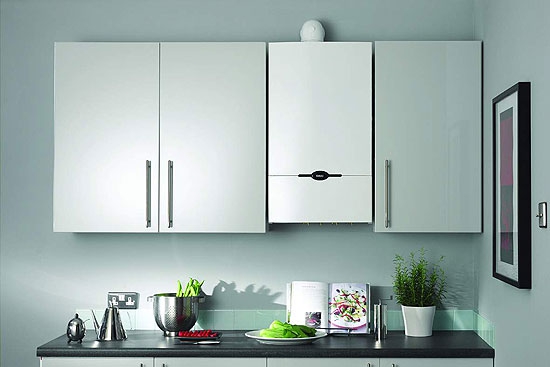Types of old gas boilers. Technical characteristics of gas double-circuit boilers
In this article: condensing boiler - what's the catch; how can a boiler have an efficiency of 105%; pros and cons of condensing boilers; review of three brands of gas boilers with determination of the best; choice gas boiler depends on several criteria other than price.
Why are gas boilers the most popular among homeowners? The answer is simple - a more profitable source of energy used for heating a home and heating water for domestic needs than mains natural gas does not exist today. So, all that remains is to choose a gas boiler, guided by... what? Price, admonitions from sellers, various recommendations from relatives and friends, brand recognition? Description of condensing boilers, recommendations for choosing a conventional gas boiler, comparative analysis several models in order to determine the best among them - in this article.
Condensing (condenser) gas boiler
We will return to the choice of conventional gas boilers later, but for now we will consider one interesting subtype of them - condensing boilers, the manufacturers of which promise an efficiency of over 100%. How is this even possible - the efficiency is more than 100%, because this contradicts the basics of physics?
A conventional gas boiler, the models of which are widespread in the CIS, transfers the thermal energy obtained from burning natural gas to the coolant heating system through a steel or cast iron heat exchanger. However, the resulting flue gases and water vapor, the temperature of which is about 120 °C, are not used for heating purposes. Heat from steam in a conventional boiler cannot be transferred to the coolant, since the moisture contained in it is extremely harmful to its structure, since when it cools and condenses, corrosive wear, a significant deterioration in the quality of gas combustion and condensate deposits on the surfaces of the chimney are inevitable. The loss of thermal energy evaporating along with steam amounts to about 10% of the total productivity of a gas boiler per unit of time.
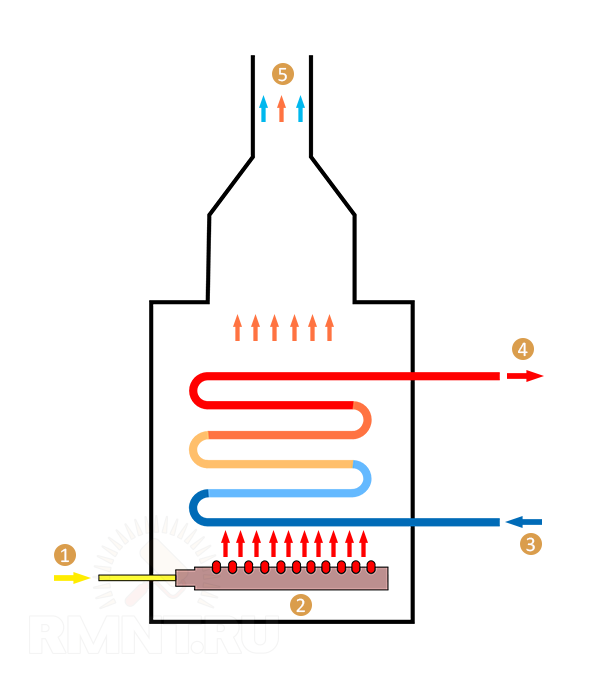 The operating principle of a conventional gas boiler: 1 - gas supply; 2 - atmospheric burner; 3 - coolant return; 4—output of heated coolant; 5 - combustion products
The operating principle of a conventional gas boiler: 1 - gas supply; 2 - atmospheric burner; 3 - coolant return; 4—output of heated coolant; 5 - combustion products
The water vapor contained in the flue gases condenses at certain coolant temperatures - less than 57 °C. The lower the temperature of the coolant, the more intense the condensation, and accordingly, the more thermal energy is taken from the water vapor. The maximum efficiency of a condensing gas boiler is achieved at the lowest coolant temperature in the return circuit of the heating system. For example, with a temperature difference between supply and return of 15 °C (supply 80 °C, return 65 °C), the efficiency of a condensing boiler will be no more than 97%, i.e. a particularly noticeable difference with the efficiency of a conventional gas boiler (93-95 %) will not be. To achieve the highest performance, the condensing boiler must be installed in low-temperature heating systems, i.e. the optimal temperature difference between supply and return is 50 and 30 °C, respectively. Only in this case is a boiler efficiency of about 107% achieved with simultaneous natural gas savings of about 17% due to the atmospheric burner.
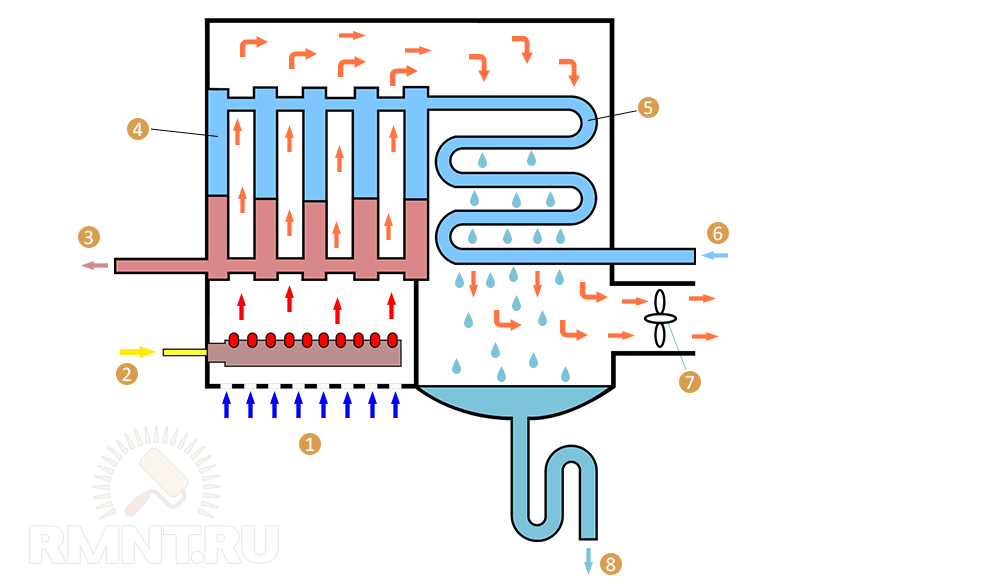 Scheme of operation of a condensing boiler: 1 - burner air; 2—gas supply; 3 - coolant outlet; 4 - primary heat exchanger; 5 - recovery heat exchanger; 6 — coolant supply; 7 - smoke exhauster; 8 — condensate drain
Scheme of operation of a condensing boiler: 1 - burner air; 2—gas supply; 3 - coolant outlet; 4 - primary heat exchanger; 5 - recovery heat exchanger; 6 — coolant supply; 7 - smoke exhauster; 8 — condensate drain
Condensing gas boilers, capable of extracting thermal energy from water steam, are equipped with a special heat exchanger-recuperator, in which this steam condenses and releases heat to the water circulating in the heating system. In the design of such boilers, two types of heat exchangers are used - plate (finned) and tubular.
The plate heat exchanger is a honeycomb structure formed by thin metal panels welded together with a 90° rotation between each pair of panels. Plate recuperators usually have significant dimensions, so they are most often used in large-sized condensing boilers for industrial and domestic use. The tubular recuperator consists of several twisted tubes with thin walls - in each of them a vortex flow of gases is formed, pressing against the walls, which makes it possible to increase the intensity of heat exchange and at the same time reduce the resistance of the channel through which flue gases pass. By the way, it is tubular recuperators that are used in supply valves built into airtight plastic window frames. Due to their small size and fairly high efficiency, tubular heat exchangers are widely used in the design of domestic condensing boilers.
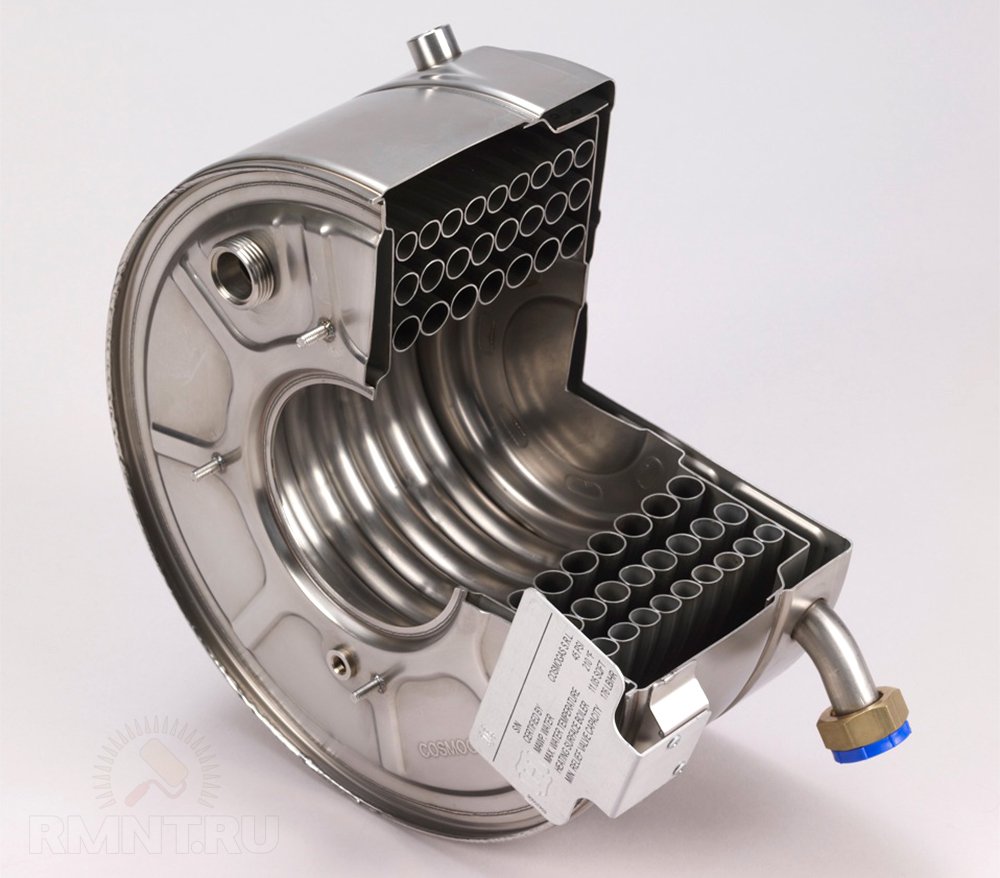
The design of the condensing boiler includes two heat exchangers - primary and recovery. The primary heat exchanger is made of cast iron or steel, it is identical to the heat exchangers of conventional gas boilers, and is capable of removing most heat generated by the burner flame. A plate or tubular recuperator is installed along the path of flue gases inside the boiler body - it extracts the remaining thermal energy by condensing water vapor at a coolant temperature below the dew point. The coolant passing through the pipes inside the recuperator absorbs thermal energy, and the resulting liquid condensate accumulates on the walls of the heat exchanger and flows into a special tray, from there through a plastic tube into the sewer. Due to the high chemical aggression of condensate, heat exchangers and trays are made of materials resistant to chemical corrosion, such as stainless steel and silumin (an alloy of aluminum and silicon).
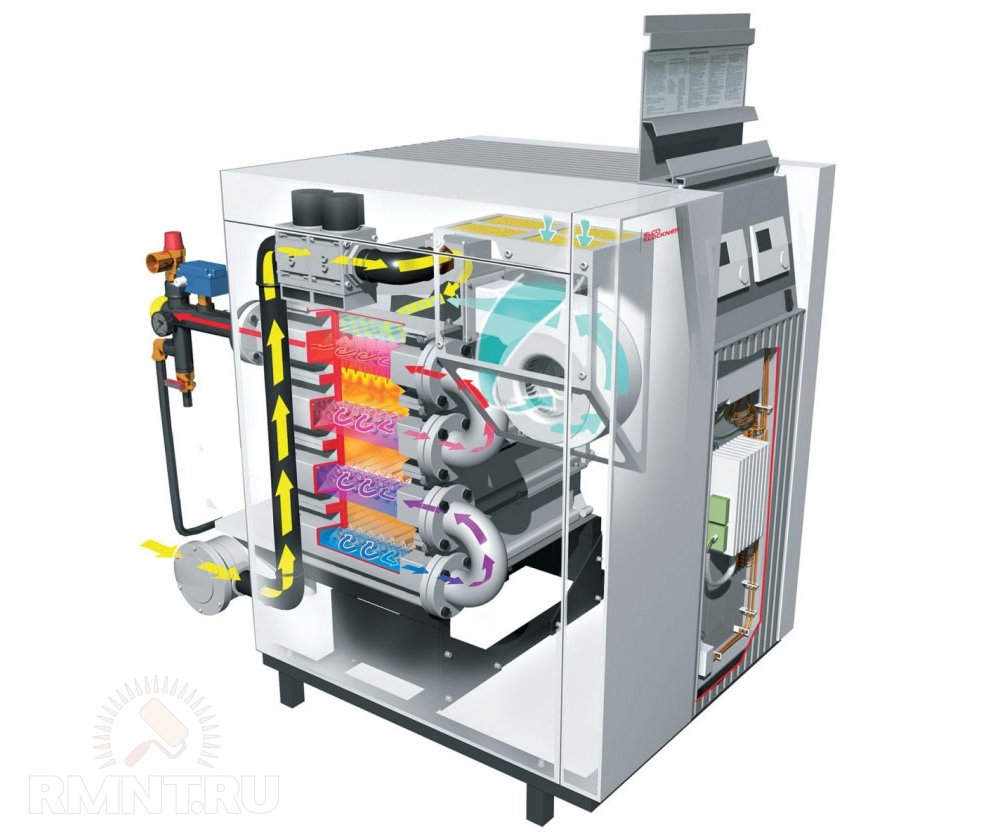
The daily volume of condensate released approximately corresponds to the power of the condensing boiler - for example, a 20 kW boiler will release about 20 liters of condensate per day. In European countries, there are strict standards regarding such condensate; due to its chemical aggression, the mandatory installation of neutralizer filters between the boiler drain and the sewer system, containing calcium or magnesium granules, is required. On this moment in Russia there are no requirements regarding the discharge of condensate from condensing gas boilers.
Where does the “extra” efficiency of condensing boilers come from?
The thermal energy generated by gas boilers was traditionally calculated based on fuel combustion (lower heat), i.e., the heat lost along with water vapor was not taken into account, since before the advent of condensing boilers it was impossible to extract it. The difference in efficiency between conventional and condensing boilers is approximately 10-15% - hence the advantages of boilers of the latter type, the efficiency of which is calculated based on the higher heat, which takes into account the heat of condensation.
![]()
In reality (from the position of higher heat) the efficiency of conventional gas boilers does not exceed 80%.
Characteristics of condensing boilers
Gas boilers of this type have many positive aspects:
- high power with compact dimensions. For example, wall-mounted gas boilers of conventional design cannot have a power greater than 35 kW, and for wall-mounted condensing boilers the power is limited to 120 kW;
- heat loss does not exceed 2% of the total generated thermal energy;
- a specially designed burner allows more precise control of the boiler activation and shutdown modes, resulting in fuel savings;
- low working temperature allows them to be used in heating systems such as underfloor heating and baseboard heating - condensing boilers are ideal for a double-circuit system;
- emissions of thermal energy and harmful substances into the atmosphere are minimized;
- the use of high-quality materials in the design of heat exchangers doubles the service life of such boilers compared to conventional ones;
- with equal power, condensing boilers occupy less area than conventional gas boilers.

The greatest efficiency of condensing boilers is observed in heating systems of large buildings - from 200 m2. To heat such a house, a powerful boiler with high natural gas consumption is required, and in this case, a condensing boiler with its high efficiency and economical fuel consumption is simply irreplaceable.
Disadvantages of condensing boilers:
- the need for a sealed chimney with forced exhaust. At the same time, it should be noted that boilers of this design are flexible in relation to the outlet of the chimney channel, not only for floor-standing models, but also for wall-mounted ones. For conventional gas boilers, the chimney outlet is limited to a strictly defined point;
- dependence on electricity - in its absence, the boiler will automatically turn off, stopping the operation of the burner and the supply of natural gas;
- The highest efficiency of a condensing boiler is achieved in low-temperature heating systems. In conventional heating systems, with a coolant temperature within 80 °C, the efficiency of such a boiler is no different from the performance of a conventional gas boiler, since secondary heat will not be collected;
- high price, explained by the expensive materials used in the construction (more cheap materials cannot resist chemical corrosion caused by condensation). Prices for condensing boilers are twice the cost of conventional boilers.

Condensing gas boilers are not produced in Russia; mainly European products are represented by the Italian companies Baxi, Ferroli and Hermann, the German Vaillant, and the Slovak Protherm.
Comparative review of gas boilers
Let's look at three models of "conventional" type gas boilers and choose from them the best boiler to purchase. Below we will analyze the characteristics of floor-standing boilers from three manufacturers - Baxi (Italy), Protherm (Slovakia) and JSC ZhMZ (Russia). The thermal power of the described models is approximately 16 kW.
| Characteristics | |||
| Thermal characteristics | |||
| Rated power, kW | 14,9 | 17 | 17,4 |
| Heated area, m2 | 130 | 140 | 140 |
| Efficiency, % | 90 | 90 | 88 |
| Maximum water temperature in the heat exchanger, °C | 85 | 85 | 90 |
| Operating temperature ranges | |||
| First stage (radiator heating), °C | 30-85 | up to 85 | up to 90 |
| Second stage (warm floor), °C | 30-45 | No | No |
| Ignition | |||
| Ignition type | electric | piezoelectric element | piezoelectric element |
| Energy consumption | |||
| Mains frequency, Hz | 50 | — | — |
| Electricity consumption, W | 120 | — | — |
| Control | |||
| Working thermostat | electronic | mechanical | mechanical |
| Safety switch | There is | There is | There is |
| Automatic shutdown of gas supply when the flame goes out | There is | There is | There is |
| Automatic shutdown when overheating | There is | There is | There is |
| Traction sensor | There is | There is | There is |
| General characteristics | |||
| Type of shell | vertical monoblock | vertical monoblock | vertical monoblock |
| Housing material | cast iron and steel | cast iron and steel | steel |
| Case shape | rectangular | rectangular | rounded |
| type of instalation | floor | floor | floor |
| Combustion chamber type | open | open | open |
| Heat exchanger material | cast iron | cast iron | steel |
| Burner type | atmospheric | atmospheric | atmospheric |
| Fuel type (with replacement of the burner with a fan burner) | G20/G30 | G20/G30 | G20/G30 |
| Inlet pressure of G20 fuel (methane gas), mbar | 20 | 13-20 | 6,5-18 |
| Fuel inlet pressure G30 (liquefied butane), mbar | 30 | 29 | 20-36 |
| Maximum fuel consumption G20, m 3 / h | 1,74 | 2,14 | 1,87 |
| Fuel consumption G30, kg/h | 1,12 | 1,8 | 1,3 |
| Number of circuits | one | one | one |
| Coolant | water | water | water/antifreeze |
| Electronic flame modulation | There is | No | No |
| Hydraulic devices included (pump, expansion tank, pressure gauge) | There is | No | No |
| Heat exchanger capacity, l | 9 | 9,1 | — |
| Noise level at a distance of a meter from the boiler, dB | — | no more than 55 | — |
| Storage boiler capacity, l | additional option | additional option | 64 |
| Flue gas removal method | natural draft chimney | natural draft chimney | natural draft chimney |
| Chimney diameter, cm | 11 | 13 | 13,5 |
| Size HxWxD, cm | 85x35x52 | 88x42x60 | 105x42x48 |
| Weight (without water), kg | 89 | 90 | 49 |
| Brand owner | BAXI S.p.A., Italy | Protherm Production s.r.o., Slovakia | JSC Zhukovsky Machine-Building Plant, Russia |
| Country of origin | Italy | Slovakia | Russia |
| Warranty, years | 2 | 2 | 3 |
| Estimated service life, years | 14 | 14 | 14 |
| Other options | |||
| Frost protection | There is | No | No |
| Timer | additional option | No | No |
| Average cost, rub. | |||
| 40 000 | 38 000 | 17 000 | |
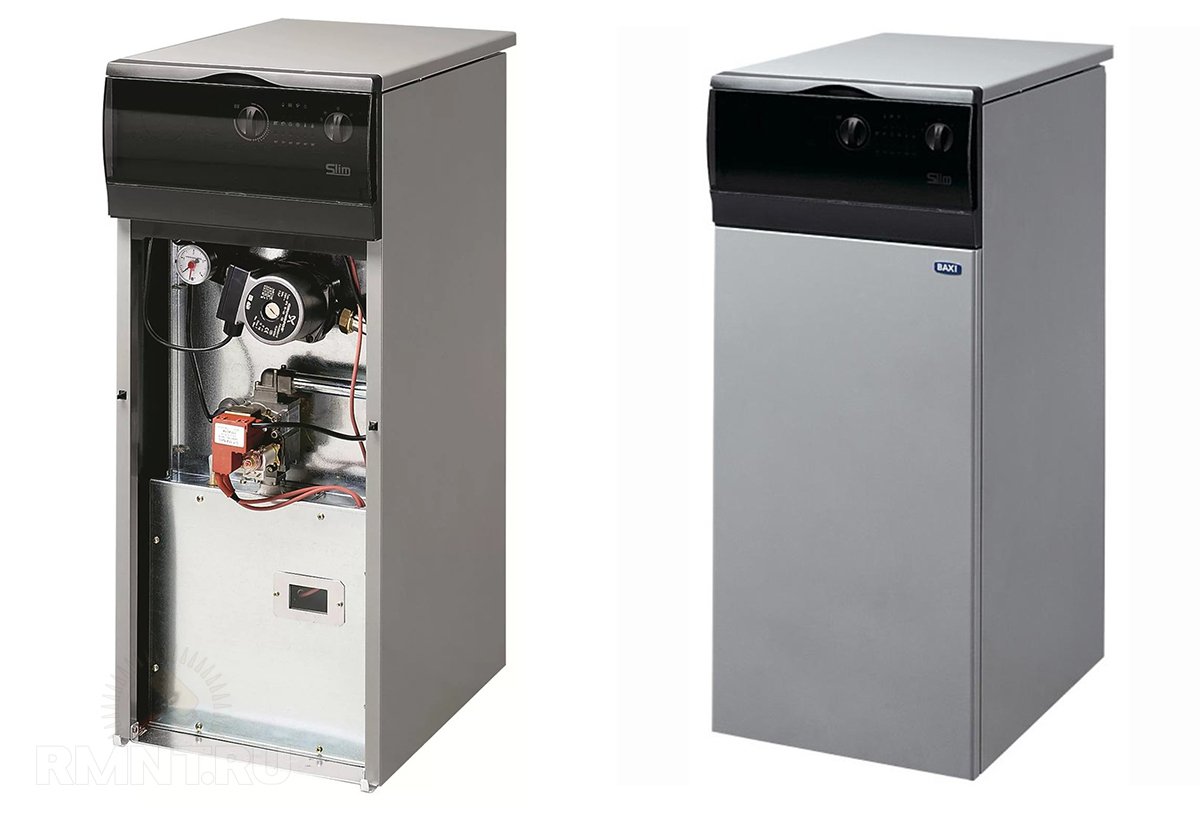
Let's analyze the data collected in the table:
- boilers of the Baxi and Protherm brands are equipped with a reliable and durable cast-iron heat exchanger, the boiler of JSC ZhMZ is equipped with a cheaper and less reliable steel one;
- ignition of the above-mentioned boilers of the Protherm and JSC ZhMZ brands is carried out by a piezoelectric element, i.e. without consuming electricity;
- The electronic control of the Baxi boiler is capable of independently and accurately adjusting the operation of the atmospheric burner, adapting to data from temperature sensors in the room and outside the building. For this reason, this boiler has the lowest gas consumption among the described models;
- Among these models, only the boiler produced by JSC ZhMZ has a built-in boiler for heating water for domestic needs;
- auto mode turning on and off the heating boiler is present only in Baxi; the other two boilers with piezo ignition can only turn off when the pressure in the gas supply drops, but they cannot turn on on their own;
- the cost of the Zhukovsky Machine-Building Plant boiler is half that of models from European manufacturers, and the AOGV-17.4-3 “Comfort” boiler is equipped with Honeywell mechanical automation made in Germany, which will last much longer and more efficiently than a domestically produced automation kit;
- Each of the boiler models presented in the review is capable of operating both on gaseous fuel (methane) and liquid fuel (propane, butane), however, for the second case, a fan burner will be required, the cost of which, depending on the power, will be at least 15,000 rubles;
- The gas boiler of JSC ZhMZ presented in the table review is capable of operating at twice the pressure in the natural gas supply network - the situation with a drop in pressure in the gas pipeline is common in Russia. While imported boilers will stop operating if the pressure in the gas pipeline drops below 13 mbar;
- only the AOGV-17.4-3 “Comfort” boiler allows the use of two types of coolant in the heating system - water or antifreeze (although there are a number of factory requirements for brands of antifreeze).
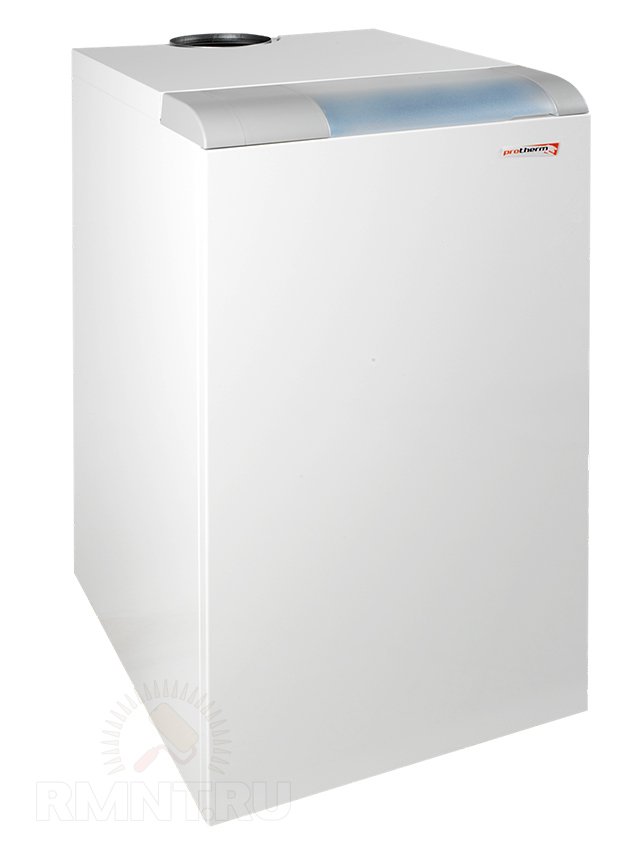
Conclusion: According to the results of the review, the AOGV-17.4-3 “Comfort” model, produced by JSC “ZhMZ”, has an undoubted advantage - and it is the “comfort” class model, and not the cheaper “economy” or “standard” (the difference in price is about 3000 -4000 rub.), equipped with German automatic equipment. The boilers of the Zhukovsky Machine-Building Plant, although not equipped with a cast-iron heat exchanger, are most adapted to unstable pressure in the gas pipeline; they are more suitable for use in heating systems with a coolant temperature of 80 to 90 °C.
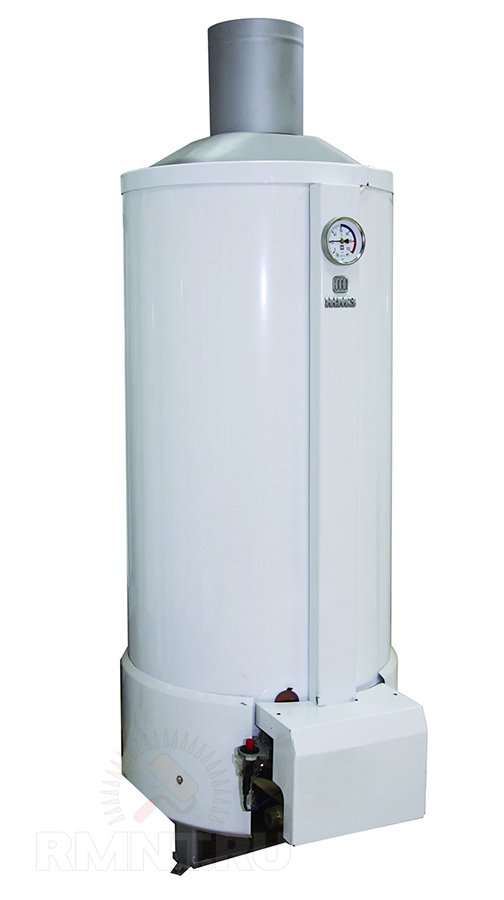
In conclusion
While natural gas is relatively cheap and available in Russia, gas boilers are and will be in constant demand. When choosing one or another boiler model, you need to decide in advance on the type and source of fuel - mainline or autonomous gas supply, the type of heating system - conventional (coolant heating up to 90 °C) or low-temperature (with water heating no more than 45 °C). An equally important initial value for choosing a boiler will be the heating area - if it exceeds two hundred square meters, then it is more profitable to purchase an economical and high-performance condensing boiler, albeit at a higher price than conventional gas boilers.
Regardless of the type of heating system of a private house, cottage or cottage, its main element is the heat generator. The fundamental point when choosing a heating device is the energy carrier on which it will operate. In addition, the technical characteristics of the device and its design should be taken into account.
If there is access to a central gas pipeline, and the area of the heated room is less than 200 m², it is advisable to install a wall-mounted one for heating. This is one of the most common and affordable options heating equipment to date.
Device design
The water heater device includes the following main elements:

- burner;
- gas fittings (filters, taps, fuses);
- heat exchanger;
- built-in circulation pump;
- automation.
Heat exchanger
The main attention should be paid to the heat exchanger, which can be made of different materials, because the duration of operation of the equipment depends on this. For example, wall-mounted gas boilers with a cast iron heat exchanger will last for many years. However, it is difficult to install such units due to their heavy weight.

Devices with a copper heat exchanger weigh much lighter, and their price is much lower. A steel heat exchanger has high heat transfer, but is susceptible to corrosion.
Technical specifications
When choosing a wall-mounted gas boiler for a private home, first of all, you should take into account its technical characteristics. Main parameters:
- performance;
- volume of water consumed;
- ignition type;
- number of circuits.
Power
On average, heating 10 m² of private house or cottage area with a ceiling height of 3 m requires 1 kW of heat. However, when making calculations, a combination of several factors should be taken into account: the number of storeys of the building, the thermal insulation of the walls, the height of the ceilings, the number of windows and doors.
Contour
Double-circuit wall-mounted gas boilers will easily provide hot water supply to a kitchen sink, washbasin and bathroom. If you plan to organize the supply of hot water elsewhere, it is better to install a device with one heating circuit. In this case, to supply hot water, you need to purchase a boiler.
Ignition
There may be two types; which one is better to choose is determined by the owner of the house. Electric ignition is carried out automatically using a spark. This method is more economical and safe, but it has a significant drawback - energy dependence.

If there are power outages in your area of residence, it is better to install a wall-mounted gas boiler with piezo ignition. In this case, the device is turned on using a button that ignites the igniter. When the boiler is turned off, the wick itself does not go out, so this method is not very economical.
Operating principle
A wall-mounted gas boiler does not require constant intervention. The entire process is controlled and regulated automatically; you just need to configure the equipment correctly.
The automation set in a certain mode turns the device on and off. Control of operating parameters is also carried out automatically. The system will not allow overheating or increase in pressure, and will adjust the volume of liquid if necessary.
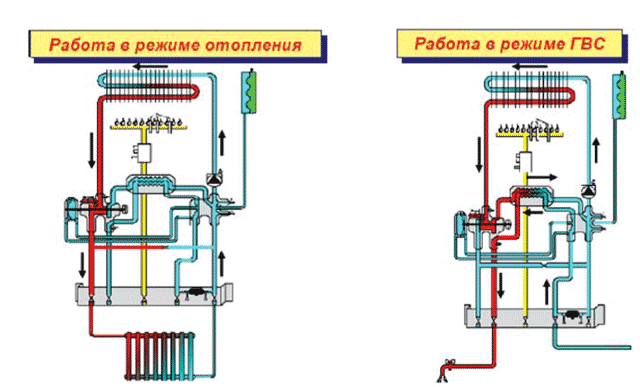
The gas burner heats the heat exchanger through which the coolant passes. By using circulation pump its further movement occurs in the heating system.
Features of water heaters
Wall-mounted gas boilers will successfully cope with heating the room if used within a given range. In order to choose the right heating device, you should take into account not only its technical characteristics, design and operating principle. It is also worth paying attention to the positive and negative properties of the equipment.
Advantages
- ease of installation;
- low cost of fuel;
- reliability;
- no need for additional care;
- the ability to maintain a comfortable temperature at any time of the year;
- compactness;
- ergonomic design.
Flaws
As a rule, household wall-mounted gas boilers are not very powerful, so they are not suitable for heating large mansions. Another negative factor concerns dual-circuit devices equipped with a three-way valve. If necessary, use hot water heating of the coolant stops. If hot water turns on for a long time, cooling the system is possible.
The boiler heat exchanger, especially if it is made of steel, is sensitive to chemicals contained in the coolant and is susceptible to corrosion. To avoid its premature failure, you should install a softening filter or clean the heat exchanger of accumulated salts after the heating season.
Smoke removal

There are two types of smoke removal methods: natural and forced. Which one is better to use depends on several factors: the condition of the chimney, room ventilation, etc.
Natural
Often, a wall-mounted gas boiler is installed with a natural chimney. In this case, the smoke is exhausted through a vertical pipe passing through the roof. The only condition for this method is the presence of good ventilation in the room where the water heater is installed.
Forced
If a private house does not have a chimney pipe or its condition leaves much to be desired, it is recommended to purchase a device with a built-in fan. Then the smoke can be removed through a hole in the wall, although such equipment will cost a little more.
Coaxial
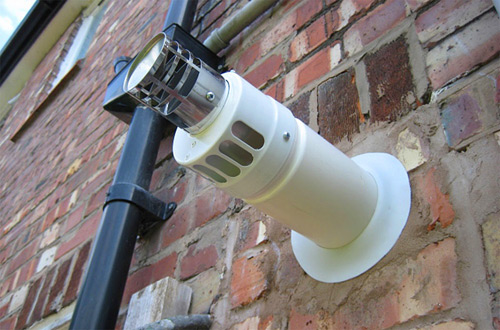
Modern wall-mounted gas boilers are equipped with a coaxial smoke exhaust system. This is a special chimney in which one pipe is located inside another. The smoke is removed through the inner pipe, and air is supplied to the burner through the outer pipe. The advantage of such a system is that the pipe can be located both in a vertical and horizontal plane.
Equipment selection
Despite the rapid development of alternative types of heating, household heating appliances running on gas are recognized as the most optimal use case. In terms of technical characteristics, maintenance, equipment cost and fuel price, gas boilers are unrivaled.
In order to find out which boiler is best to install, you need to determine the power needs and additional functions. For a private house with a large area, it is advisable to purchase a floor-standing device. Such devices with a cast iron heat exchanger are more reliable and economical.
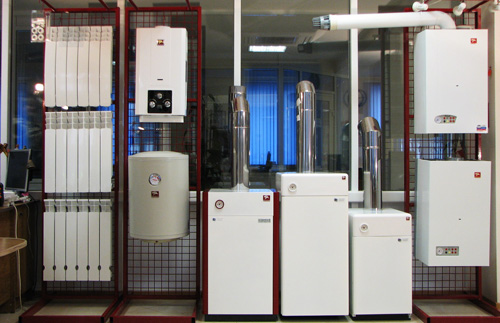
Wall-mounted units are usually equipped with a steel or copper heat exchanger. They take up little space, so they are more suitable for a summer house or small cottage. While a floor-standing boiler often requires a separate room due to its overall dimensions and heavy weight.
Many household models, both floor-mounted and wall-mounted, are equipped with an additional hot water circuit, this will save you from unnecessary costs for purchasing additional heating devices.
Installation work
Installation of a wall-mounted gas boiler is carried out by specialists in strict accordance with the rules and instructions. Before starting work, prepare the wall on which the device will be installed. A protective non-flammable layer is applied to it. The gap between the boiler and the wall should be 4.5 cm.

Then water is passed through the device, which washes away dust and small debris that has settled on the walls after assembly. After this, install the filter and shut-off and control valves.
At the next stage, the chimney duct is installed and the draft is checked. Next, connect to the central gas pipeline using metal pipe and a special drive. The installation of a wall-mounted gas boiler is completed by connecting the automation and testing the system.
The choice of gas heating equipment is very rich and varied. How to choose the right option?
If the choice fell on a gas double-circuit boiler, then this is not an exhaustive characteristic.
There are many types of double-circuit boilers.
Gas boilers according to various criteria, they can be classified by type of installation, by purpose, by type of fuel burned, by energy consumption, by type of traction, by the method of preparing water for hot water supply, by type of ignition and by the efficiency of using combustion heat.
Installation type:
- Wall-mounted (hanging).

- Floor-standing (stationary).
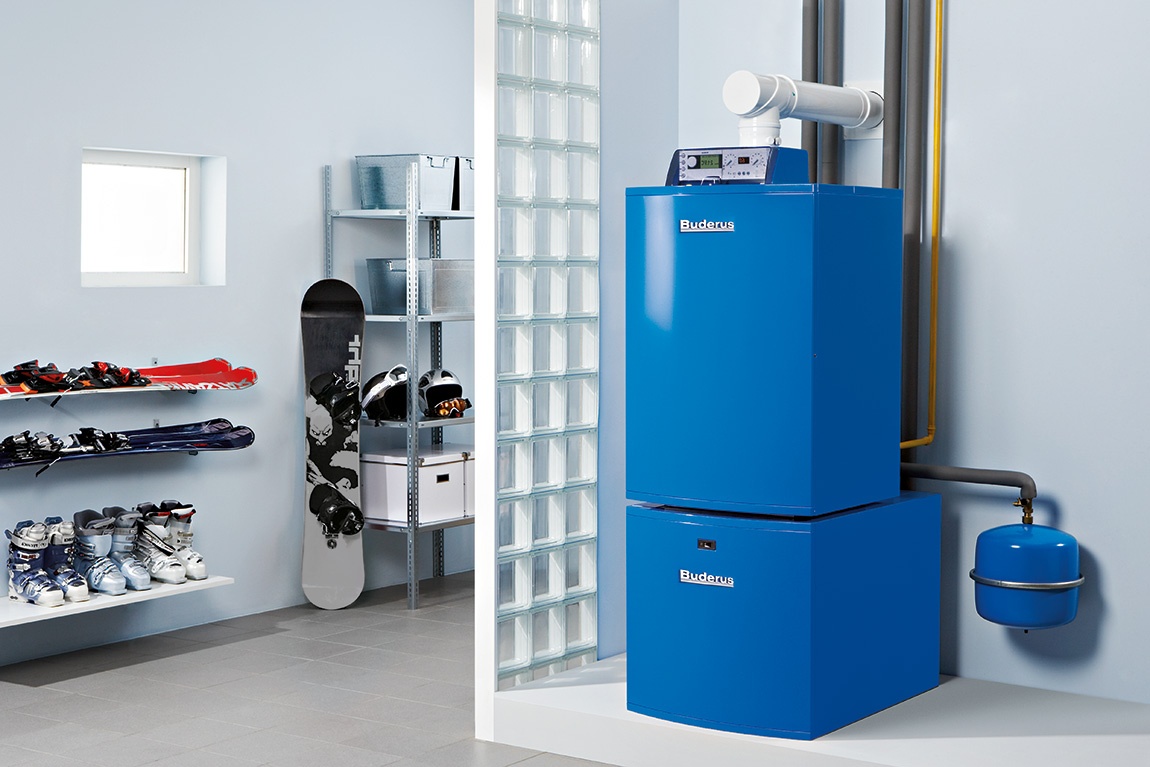
Purpose:
- Domestic low-power boilers.
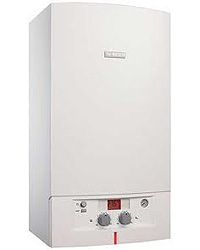
- Industrial high-power units.
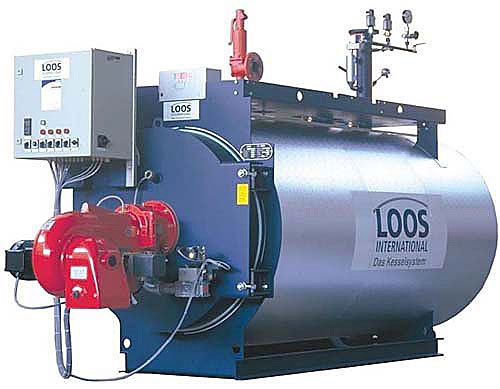
Type of fuel burned:
- Liquefied gas – propane-butane mixture.
- Gaseous – natural gas (methane).
Type of energy consumption:
- Low-power boilers operate on a 220 V network.
- High-power boilers operate on a 380 V network.
- Non-volatile boilers do not consume electricity at all.
Traction type:
- Natural draft requires a flue of a certain size.
- Forced draft is provided by a fan.
Method of preparing water for a hot water supply system:
- According to the flow circuit using a bithermal heat exchanger.
- According to the storage scheme in the built-in boiler.
Ignition type:
- Electronic – more economical and functional.
- With the help of piezo - does not require electricity.
Efficiency of combustion heat use:
- Convection - traditional boilers. The combustion products leaving the boiler have a temperature of more than 1000C.
- Condensing – modernized boilers. Combustion products at the outlet have a temperature of less than 500C. The efficiency is much higher.
On a note.
If all passport requirements are met, it is possible to install a gas boiler yourself. But connection to the gas pipeline and commissioning work must be carried out by qualified persons.
Passport data of the gas boiler
When choosing a gas boiler, you need to study its detailed characteristics.
- Power is a measure of heat output. For a rough calculation, you can use the following formula: 2 kW of boiler power per 10 m2 of area of the heated object, provided that the height of the rooms is 2.5 m. But it must be taken into account that some of the heat will be spent on heating water for the hot water system.
- The fuel used is natural or propane.
- Efficiency is an indicator of the efficiency of using heat from a flame; it expresses efficiency.
- Flue gas temperature.
- The coolant used is water (condensate) or antifreeze.
- Maximum operating coolant pressure - this parameter must be suitable for all elements of the heating system.
- Maximum coolant temperature at the boiler outlet.
- Aerodynamic resistance of the firebox at maximum power - this parameter indicates the required fan power to remove combustion products.
- Hydraulic resistance at maximum power - this parameter indicates the difficulty of coolant passing through the hydraulic system of the unit.
- The flow-type domestic hot water capacity indicates the volume of water that the boiler can heat in 1 minute. This parameter depends on how much the water needs to be heated.
If the hot water supply is storage type, then the volume of the tank and its heating rate must be indicated. - Maximum gas flow through the burner. The calculation must be made for two main types of fuel: natural gas and propane.
- Operating gas supply pressure. The lower the permissible values of gas pressure, the more stable the operation of the boiler will be during sudden surges.
- Electrical network parameters: voltage (V) and current frequency (Hz - Hertz).
- Electrical power consumption (W – watt).
- Overall dimensions of the unit.
- Unit weight.
- Dimensions of fittings for connection (DN – nominal diameter). For heating, for hot water supply.
- Diameter of the flue.
The characteristics of the boiler cannot be good or bad; they must be suitable for the conditions in which the boiler will be operated. It cannot be said that the boiler has a power of 1000 kW. better than a 20 kW boiler. These two units have different purposes.
On a note.
For effective use gas equipment, it is necessary to calculate the heat loss of the heated building. It is better to entrust this calculation to specialists.
Selection of the necessary characteristics
For heating a living area of up to 100 m2, a boiler with a power of 20 kW is suitable. If you use a boiler with more power, its operation will be less efficient and economical. The characteristics of boilers are needed in order to rationally use all their functions.
A non-volatile floor-standing gas boiler is an excellent option for heating a facility with a large area, but without power supply.
Gas double-circuit floor heating boilers are well suited for heating and hot water supply in a private residential building.
Wall gas double-circuit boilers Perfect for heating and hot water supply in a medium-sized private house or apartment.
A boiler with suitable characteristics will heat the room sufficiently without wasting fuel.
Whether at home or at work, there is always a need for energy various types: electrical, thermal, mechanical, etc.
One of the types of energy production is the combustion of fuel in special units - boilers.
A boiler is a unit in which heating occurs cold water by burning fuel or using electricity (electric boiler).
Industrial is a boiler that is used in production.
A domestic boiler is a boiler that is used at home.
According to the degree of water heating, industrial boilers are divided into hot water and steam. The end product of hot water boilers is hot water, and steam boilers - steam. The manufactured products must have certain parameters, namely: temperature, pressure and flow, which are individual for each unit.
Industrial boilers are used to provide heat supply to industrial and residential premises, and can also participate in technological processes.
An industrial gas boiler is a device for heating a coolant by burning gaseous fuel. Most often this is natural gas (methane) or propane-butane.

Industrial gas boiler
Industrial boilers can be divided into:
- Gas.
- Liquid fuel.
- Solid fuel.
- Electrical.
- Combined.
Advantages of gas boilers
The widespread use of gas boilers in industry is associated with a number of advantages:
- Gas is one of the most affordable types of fuel.
- Its combustion products do not require additional equipment for flue gas purification.
- Gas boilers are very easy to use. Almost the entire operating process is automated.
- The heat obtained using a gas boiler is the most cost-effective, as it has a high calorie content and a fairly low cost.
- An important advantage is the compact design and ease of installation/disassembly.
- A large selection of units is available according to function and purpose. You can choose a boiler for any room, regardless of purpose and heated area.
- It is very easy to purchase a gas boiler in any convenient way: through a sales representative or in special stores.
Important!
Before purchasing a boiler, you need to calculate the heat loss of the building taking into account the heated area. This calculation is best left to professionals.
Gas boiler design
A gas boiler consists of several elements: firebox, burner, heat exchanger, etc.
- One of the most important elements of an industrial boiler is the firebox - the place where fuel combustion occurs. In domestic boilers, the firebox is called the combustion chamber.
- In order for the fuel to burn with the greatest efficiency, it is supplied through a special device called a burner. The design of the burners directly depends on the type of gas burned. The number of burners may vary depending on the types and sizes of the boiler.
- The boiler includes a heat exchanger - a reservoir containing water that needs to be heated. The heat exchanger consists of small diameter tubes - this ensures fast and high-quality heating of water. The heat exchanger is usually located above the combustion chamber. Water is heated due to radiated heat from the flame of the combusted gas (radiative heat transfer), as well as due to the contact of hot combustion products with the heat exchanger tubes (convection heat transfer).
- To support the combustion process, air supply to the combustion chamber is necessary. It can be done naturally or with the help of a fan. There is a need to remove combustion products from the smoke duct. This process can also be provided by natural draft or using a smoke exhauster.
- Additional equipment of the boiler is a pump for pumping water through the heat exchanger to the consumer.
- Automatic sensors for various purposes, fittings for supplying and discharging water, gas and air, automation systems, protection and interlocks.
The principle of operation of a gas boiler
In order to put the boiler into operation, it is equipped with a piezo or other automatic system, which ignites the igniter using a spark. This device always ignites first and is constantly lit, in case of unexpected burner extinguishing.
Then gas is supplied, which is ignited by the igniter flame. The heat released from gas combustion heats the water in the heat exchanger, which is pumped to the consumer using a pump.
With the start of the combustion process, a fan is turned on to supply air and also to remove flue gases. Using a thermostat, the temperature of the coolant is automatically controlled by regulating the gas flow. You need to manually set the required temperature within the available control range.
Attention!
Supplying gas to the boiler is prohibited when the igniter is turned off, as this may lead to an explosion. The entire process of gas supply and its termination when extinguished is fully automated using modern electronic technologies, and is also provided with reliable and automatic explosion protection.
Differences between boilers depending on the type of gas burned
The main types of fuel for gas boilers are natural gas (methane), which is lighter than air in its properties and characteristics, and propane-butane mixture is liquefied gas, which is heavier than air.
Due to these differences, some design features of the burners also change. That is, a boiler operating on methane differs from a boiler operating on propane-butane only in the design of the burner, and the rest of the operating principle and design are the same.
Types of boilers depending on the installation method
Depending on the installation method, boilers are:
- Stationary (floor-standing) are high-power boilers that are installed on the floor or a special platform. As a rule, floor-standing boilers are quite large in size and heavy weight- this is justified by the fact that the boiler elements are made of high-strength materials, which significantly increases the productivity of the unit. Such boilers operate at increased power - up to several megawatts (MW).
- Mounted (wall-mounted) are low-power, compact boilers made of lightweight material, which are hung on the wall, thereby taking up very little space. The performance of such boilers is small enough for heating large areas, but is suitable for small private houses and apartments.
![]()
Mounted compact gas boiler
Differences in gas boilers by functionality
The main purpose of industrial gas boilers is heating residential and production premises, as well as hot water supply. Based functionality, boilers can be divided into two types:
- Single-circuit boilers are boilers that are intended only to provide heating. To provide hot water supply, you need to additionally install a capacitive water heater.
- Double-circuit boilers are boilers that combine two functions: heating water for heating and for hot water supply (DHW) at the same time. Boilers of this type have in their design a double plate heat exchanger, one of which heats water for heating, the other for hot water. The heat exchanger can be of the bithermal type. Its design is a “pipe within a pipe”, one of which provides coolant for heating, and the other for hot water supply. Double-circuit boilers can operate in different modes: supply water for both heating and hot water supply, and in the warm season you can switch to the “DHW only” mode.
Domestic and industrial gas boilers
The operating principle of domestic and industrial boilers is the same and the scope of application is also similar, but there are still differences.
- There are strict requirements for the placement of an industrial boiler, as well as for the removal of combustion products: the room must be spacious (4 sq.m. for 1 boiler), ventilated, non-living, the height of the room is not less than 2.5 meters, without flammable materials, it is necessary to have gas supply lines and water supply, availability of fire extinguishing means. The gas duct must be impenetrable, the height and diameter of the gas duct must be calculated and meet the requirements.
- Industrial boilers have higher power than domestic ones (up to several MW) and are larger in size.
- Have a higher noise level than household ones
- All industrial boiler processes are equipped with more precise automation system.
- Industrial boilers must have an explosion protection system, as well as a pump blocking system that prevents an accident in emergency cases.
- Since the productivity of industrial boilers is quite high, it is necessary to observe the water chemistry regime to reduce the formation of scale. And also the design of the boiler itself should be more resistant to temperature changes.
Gas boilers have found their use in everyday life and in industry and, despite the use of explosive fuel, they are safe to use provided all requirements are met.

